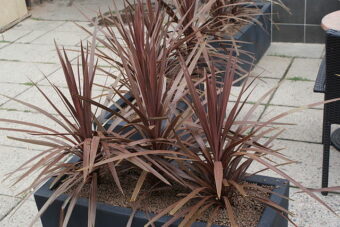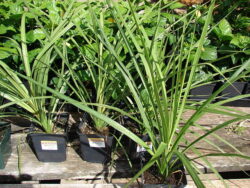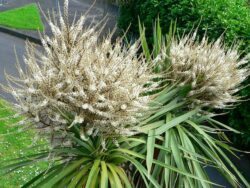In this article, we will be discussing how to grow this colourful plant of Cordyline in containers. If you want a plant that has striking architectural leaves in a container then this is the plant for you. It is such a bold and handsome shrub that slowly grows into a tree-like plant. The cordylines are grown for their single trunk or multiple trunks who are topped with dense tufts of long, colourful, leathery leaves that can be variegated.

It has many common names from cabbage palm, Torbay Palm or New Zealand cabbage tree. It is not a palm and most certainly looks nothing like a cabbage.
The most widely grown specimen in containers is Cordyline australis, which has a large range of cultivars that are often variegated and multi-coloured. The green-leaved forms tend to grow quicker and are often not suitable to grow in containers unless you are prepared to regularly repot, whilst the multi-coloured or variegated varieties grow only to 3m and are less vigorous.
Young specimens are preferred to be grown in containers, where the sword-like leaves can be planted as a centrepiece in a large pot. Even better is to place it in a vase on a pedestal that is surrounded by low growing and trailing plants.
The biggest problem is that green varieties tend to be the most frost tolerate but they generally get too big for containers. This is why it will be beneficial to grow the coloured varieties in pots, where they can be moved for winter protection and are easier to wrap up with thick, horticultural fleece.
If your plant is mature enough it may surprise you and produce a spike of white flower that will add to its appeal.
HOW TO GROW CORDYLINES IN CONTAINERS
Most cordylines are hardy to minus 5 degrees Celsius and so will survive most UK winters, unless you live in a cold area of the British Isles. This is why it is best to grow cordylines in pots, especially if you in cold regions of the UK, where they can be moved to the protection of a greenhouse or be covered with horticultural fleece.
It is best to grow them as a specimen plant in a border, where its strong vertical shape has a handsome contrast to other plants.
If you grow green cordylines in containers, place them in full sun, but if you are growing the variegated or coloured varieties place them in light shade. Place the pot away from strong winds in a sheltered spot.
When you use a pot use a container as large as possible, where often a half-size wooden barrel is preferred. The advantage of doing this is that it will not need to be rehoused every year or two, but makes it harder to relocate in winter.
If you are going to plant the shrub in a half barrel that you should cover the plant with horticultural fleece when frosty weather is forecasted rather than move it. Your back will thank you later. Once it has outgrown the largest possibly container size then you will need to plant it in the ground or get another specimen. The container that you use must have drainage holes to stop the plant from sitting in constant moisture.
USE A MIX OF MULTIPURPOSE COMPOST AND HORTICULTURAL GRIT
Plant your cordylines you will need to make sure that the plant in a 50% mix of multipurpose compost with 50% horticultural grit to make a free-draining growing media. Make sure it is placed in the centre and the plant is firmed in. You will need to make sure the growing media is regularly watered and that it is moist at all times but never soggy. To avoid the build-up of harmful salts, you will need to periodically wash the compost to remove them.

As the shrub matures its characteristic trunk appears as it grows up. As it does so the leaves will start to yellow and die off, exposing the growing trunk. These old leaves will need to be trimmed off. Keep doing this as the plant matures.
In early spring, apply a single dose of slow-release fertilizer to help it grow throughout the growing season. Alternative, apply a liquid fertilizer once a month during the growing season.
WINTER CARE OF CORDYLINES
As said earlier cordylines can survive a temperature of minus 5 degrees Celsius but too much cold in winter and frosts can disfigure the leaves. To prevent this, you will need to protect the leaves by wrapping the plants with a thick course of horticultural fleece. To do this, make sure that the cordylines are dry before wrapping to make sure no moisture is present, causing the leaves to rot.
What you need to do is starting from the top and gently with soft string, wind upwards around the leaves, so that they are pulled upwards to a point. Do this with all leaves and then cover with the thickest fleece you can buy.
Do this if you cannot move your pots to a protected location, either in a greenhouse or standing against a south-facing wall of a home. This will give extra protection against the cold.
Once the weather starts to warm up in early March, you can remove the fleece and soon the plant will spring back to life.
CORDYLINE PESTS AND DISEASES
Generally, these plants are trouble-free but if the compost at the base gets too wet then stem rot can occur. Frost damage can disfigure the top growing part of the plant, especially true if a long cold spell has taken part.

In spring, if parts of the plant are clearly dead then these will need to be removed- the dead leaves and the dead stems. This can be done by either pulling the leaves away from the trunk or by cutting off these dead leaves. Do not worry as cordylines will produce new leaves from the remaining trunk or even from the ground.
Do not worry as it is easy to propagate new plants if it does not do well and form new growth.
VARIETIES TO GROW
Cordyline australis have broad green leaves that grow a thick trunk and in summer they bear white flowers. There are several varieties that can be grown, the following are recommended:
‘Albertii’ has multi-coloured green and red-veined leaves in the middle that is striped and cream/pink edged.
‘Purple Tower’ has wonderful purple-green leaves whilst ‘Red Star’ has bronze-red leaves. ‘Southern Splendour’ has dark grey-green leaves with bright pink edges. ‘Sundance’ has green leaves with bright pink central stripes and ‘Torbay Dazzler’ has dark green leaves with a white stripe in the centre.
As you can imagine you do have plenty of choices.
CONCLUSIONS
In this article, we have discussed how to grow cordyline in containers, what their preferred growing conditions are, what compost to use, and what varieties to grow. They are in general not difficult to grow as long as you are prepared to protect them from harsh winters and water them regularly.
A plant that is not only showy but looks great mixed with other plants to give an exotic feel.
If you have any questions on this topic, please do not hesitate to get in contact with me by using the contact box below.
Happy Cordyline growing.

I have several varieties of cordylines in pots, large and small. I’m going away for 10 days with no-one to water them (July/August). Will they be okay.?
Worried Jenny
Hi Jenny
It should be okay. All you need to do is give it some water and it should be okay.
Thanks
Antonio